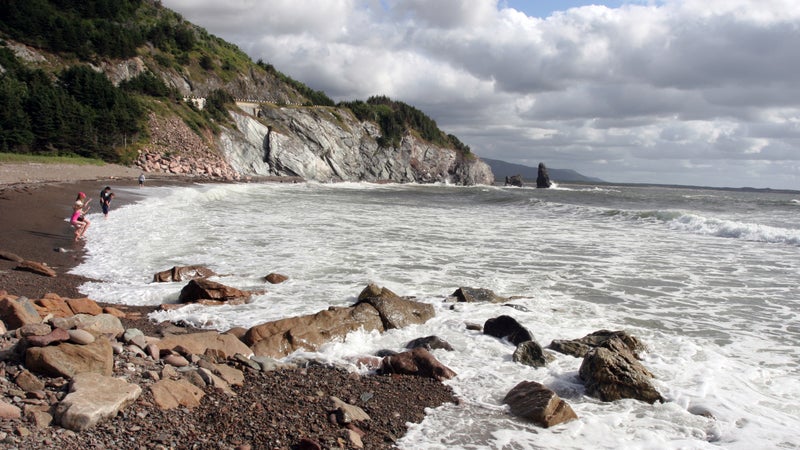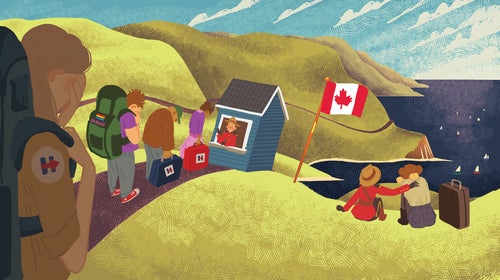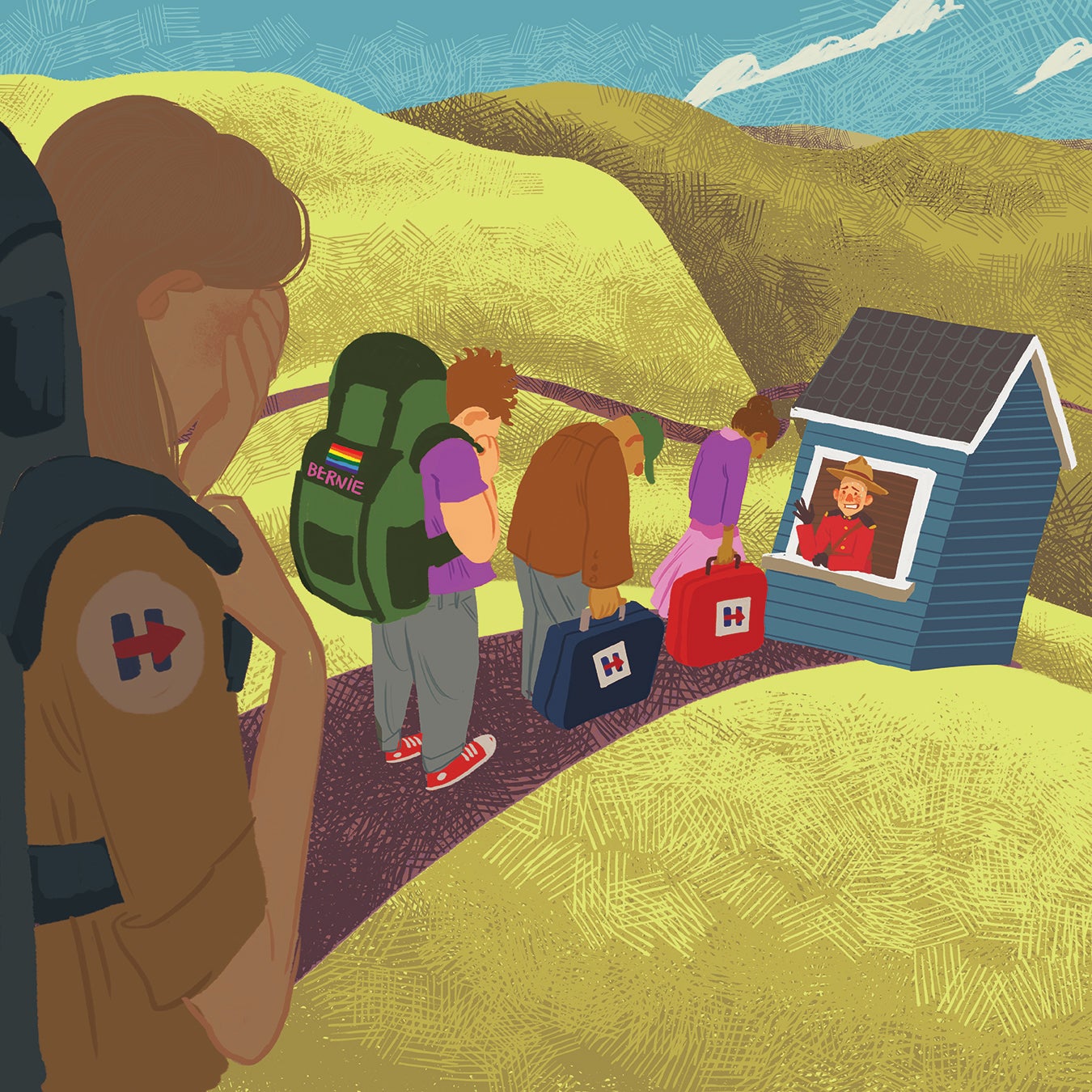As of this writing, the Trump-fearing American hordes have not descended on Cape Breton, the craggy Atlantic island that blooms off the northeastern tip of Nova Scotia like the business end of an exploding cigar.
Not yet, anyway, says Rob Calabrese, the 40-year-old radio DJ who created the (at first) tongue-in-cheek and then (inexplicably) viral website. When I drove up to Cape Breton a few weeks back, Calabrese met me for beers in the rustic-industrial taproom of Breton Brewing Company, in the port town of Sydney, the island’s service center and de facto capital.
“Going viral is one thing,” he said, sounding a bit weary and sipping a hefe, “but going viral while enraging a group of militant Trump zealots is another.” His (since streamlined) invited disaffected Americans to “start a new life in Cape Breton, where women can get abortions, Muslim people can roam freely, and the only ‘walls’ are holding up the roofs of our extremely affordable houses.” After going live in February 2016, the site earned wry shoutouts from both President Obama and Canadian Prime Minister Justin Trudeau—along with seemingly every media outlet in the United States and Canada. It’s been visited more than 2 million times, and Calabrese has marshaled a small corps of local volunteers to help him field something like 6,000 inquiries from anxious would-be expats.
“For a while, it stayed at a nice manageable pace,” Calabrese said. “Then Trump won the election, and it just exploded. Then he put in the travel ban, and there was another mini-explosion. [The inquiries] coming in now are people who are immigrants in the U.S. and are scared.”
If you ask Calabrese, Cape Breton damn well ought to welcome them. The island’s population has been in free-fall since the the 2000s, when its steel and coal industries collapsed after decades of decline. Recent census numbers put the population at just over 132,000, down from more than 158,000 in 1996—a nearly 17 percent plunge—and the grimmest metrics project a dip below 100,000 by the early 2030s. Last year, the island’s main school district shut down 17 of 52 schools. At Sydney’s 5,000-seat hockey rink, built in the 1980s and home to the major junior league team, the Cape Breton Screaming Eagles, it’s a pretty good night when fans manage to fill half the seats.
“For a while, inquiries stayed at a nice manageable pace, then Trump won the election, and it just exploded. Then he put in the travel ban, and there was another mini-explosion.”
I went to Cape Breton in February wondering if any Americans have heeded Calabrese’s call—and discovered an under-the-radar (and incredibly affordable) adventure paradise. The island is a four-season playground with a handful of disparate ecosystems sandwiched together. In the west are the Highlands, a sculpted plateau of low mountains and plunging river valleys; in the east, 200 miles of Atlantic shoreline are speckled with wild beaches and salt marshes; in between, the inland sea of Bras d’Or Lake offers 424 square miles of what Calabrese, a casual yachtsman, calls “the best sailing in Canada.” For better or worse, much of the island has reoriented toward tourism. In summer and fall, hikers and sightseers descend on the Highlands, while tens of thousands of cruise-ship passengers offload in Sydney for whale-watching day trips and sea kayaking excursions. Come winter, the tourists clear out, the Nor’easters deposit a few generous dumps, and the locals strap on skis or snowshoes to explore an abundance of forested trails.
As Calabrese’s website points out, an American in Cape Breton can enjoy all of this on the cheap, in part because the island’s economy is slumping and in part because the loonie is at a historic high against the dollar. The median sales price of a single-family home on Cape Breton hovers around $120,000 Canadian—roughly $90,000 in U.S. dollars. In the former mining town of New Victoria, you can get two bedrooms with two oceanfront acres and a lighthouse view for the U.S. equivalent of $135,000. A pint at Breton Brewing Company costs just north of four American bucks, and a full-day snowshoe rental from North Sydney’s gear shop runs you $7 and change.
Paul Finney, who opened Escape Outdoors with his wife, Sherry, in 2012, sees opportunity in Cape Breton’s natural resources and rock-bottom cost of living. I joined him on a snowshoe hike one afternoon at , about an hour outside Sydney. While he’d love the entrepreneurial pep that a wave of new immigrants (American or otherwise) would bring, Finney says he tries to take his island’s population loss in stride.
“My mom was one of 12,” Finney told me as we hiked up a steep-walled granite canyon. “I was one of six. We had one daughter. My daughter has a dog.”
When the trail ended at Uisge Bàn Falls, a 50-foot stunner in a sylvan little pocket, Finney and I stood around munching his store’s house-made granola bars. “At some point, I think we’ll reach equilibrium,” he went on. Finney looked at me, then around at the falls and the maples and the 500-foot canyon walls, as if to say, Hey, look at everything we’ve got. “There are people out there who value the outdoors, who don’t want to be in populated areas,” he said. “People are attracted to this lifestyle.”

So where are all the outdoor-loving Americans who’ve emailed Calabrese in the past year? Well, if anyone actually has moved to Cape Breton as a result of the election, he has yet to meet them. Immigrating to Canada, it turns out, is kind of a bear. In a nutshell, a determined Trump evacuee needs one of four things: a job offer from a Canadian company; a spouse or family member as a sponsor; an established track record of self-employment as a farmer, athlete, or creative; or a giant pile of money and a willingness to invest it. Unlike in the United States, a Canadian province can sponsor a foreigner based on its own immigration criteria, but Nova Scotia’s nomination program requirements include a personal net worth of $600,000 (Canadian) and a minimum investment of a cool $150,000.
“Sometimes provincial programs look great on the surface,” Damien Barry, an immigration lawyer in Sydney, explained over coffee one morning. “But my concern is that ours is metro-centric. For example, $600,000 net worth? It might be needed in Halifax, but I don’t think it’s needed in Cape Breton.”
That’s why Calabrese has taken his viral celebrity and joined a loose committee of islanders lobbying the Canadian government to give Cape Breton its own nomination program, independent from the province. Nova Scotia welcomes between 2,500 and 3,500 immigrants a year, but the great majority settles in the provincial capital of Halifax, a shipping and shipbuilding hub and with a bustling population of more than 400,000. Calabrese wants to see Cape Breton attracting 2,000 immigrants a year, with an emphasis on young families, who might find work in the island’s service industries or nascent tech sector, plus students and folks over 55. In other words, mostly people who probably aren’t sitting on 600 large. The group has been meeting since last year and is working with a high-profile Halifax attorney on a proposal to deliver to Canada’s federal immigration agency.
“This problem that made me do the website is still a problem,” Calabrese told me—that is, the low population. “We’re on the precipice of oblivion here.”
An American in Cape Breton can enjoy this adventure paradise on the cheap: the median sales price of a single-family home on Cape Breton hovers around $120,000 Canadian—roughly $90,000 in U.S. dollars.
Barry thinks a Yankee wave may still be on the horizon. The island has seen property transactions tick up in the past year, and he wonders if prospective settlers are feeling the place out with vacation homes—Americans can own property in Canada and stay half a year without a visa. What’s more, Barry said, he has a handful of new U.S. clients actively seeking paths to citizenship.
“I always ask them, ‘Why do you want to leave?’” he said. “‘Oh, I don’t like the way the States are going,’ they’ll say. I had a couple from Oklahoma up here last summer, and when I met with them, they said, ‘I don’t think you quite get it—we live in Tulsa, where there’s an open-carry policy. We genuinely live in fear of being shot at.’ You always feel it sounds dramatic, but at the end of the day, you’re hearing it from this person who made the effort to come here.”
As Barry and I talked—sitting at , a hipstery Sydney coffee shop run by a pair of Vancouver transplants—he waved over some friends from across the room. Mark and Danielle Patterson were born and raised on the island, married, and did stints in Florida and Newfoundland before returning three years ago to start an IT security company. Make no mistake, Danielle said, the “Trump bump” from the website is real—whether or not any American exiles ever materialize. “The whole island got behind all the publicity,” she said. “It’s just fed the community with excitement and momentum, like this is a place that’s special to live, like it does have a lot to offer.”
Elsewhere around Sydney, though, I found the outlook more caustic.
“We couldn’t feed 30,000 people, so we had to drown them in the harbor,” deadpanned an old duffer in a barbershop where I stopped for a trim. The salon’s proprietress, Anne, lowered her clippers and threw him some side-eye. “Always comedy hour in here, eh?” she muttered. She had the wisp of a brogue that’s common among the largely Scottish-descended Capers.
Sure, Anne said, tourism was up last year, but the truth is that Cape Breton’s young people are abandoning the island in droves, chasing jobs and opportunity in Halifax or Toronto or the oil fields in Alberta. “There’s just nothing here now,” she said. “The tourists come off the cruise ships and see all these boarded-up shops downtown.”
Did she know of any Americans who had moved up to escape the Trumpocalypse? Not yet, Anne said, and she chuckled at the thought.
“You want Americans?” croaked the duffer. “Head for the Highlands—there’s some been hiding up there since Vietnam.”

There are worse places to dodge a draft (or escape a crypto-fascist regime) than the Cape Breton Highlands, which comprise the island’s northern and western reaches and are where I spent three days after leaving Sydney. Imagine Vermont had a baby with Norway, and then Maine and Scotland raised it: fjord-like river canyons streak through a range of 1,500-foot peaks that rise up steep and misty from the shoreline. The slopes are shaggy with birch, beech, fir, and sugar maple, which turn gobsmackingly vivid come autumn. Summer and fall tourists wend along the famed Cabot Trail—a pinion-testing drive skirting sheer oceanside cliffs—stopping here and there to crack lobsters in postcard fishing villages and enjoy a veritable Lollapalooza of Gaelic tavern concerts and ceilidh dances.
In the winter, though, when 150 inches of annual snowfall render the Cabot Trail sporadically impassable, the Highlands go into a light hibernation. When I pulled into Ingonish, a seaside resort town, I could hardly find a local, much less an American alien. Year-round, only about 2,500 people live in Ingonish and the dozenish surrounding villages in its census division (down from 3,300 in 2001). If parking lots at the local ski hill, , and Nordic club, , are any indication, a lot of them were on planks that afternoon. I passed these up, though, en route to an ungroomed trail in , the 366-square-mile semiwilderness that encompasses much of the Highlands’ roadless interior.
The park’s gates were unstaffed and its visitor center closed. I skied eight miles out-and-back from an empty trailhead to a half-frozen waterfall, climbing enough to enjoy a couple whistle-worthy ocean vistas. Here and there, moose tracks two feet deep crisscrossed the trail—a gravel road in summer—and on the way down, I took a corner briskly enough to surprise a red fox who leaped and skedaddled like I’d caught him breaking and entering.
It wasn’t until the next day, though, that I started daydreaming about real estate. I spent the night at a bed and breakfast outside of Cape North, just shy of Cape Breton’s northern tip and geographically closer to excellent polar bear habitat than to a single state Trump won last fall. In the morning, while ogling the adjacent white coastal mountains, I skied another eight blissful miles of flowy and impeccably groomed trails at the . While signing in, I asked Dolores, a native Cape Northian and the clubhouse’s sole staffer, whether any American malcontents had recently relocated.
“Not yet,” she said. “We got them all in the ’70s—we like to call that our hippie stage.”
I followed the Cabot Trail south and west through arguably its most impressive stretch, with frequent overlooks of rocky cliffs and frosted green slopes pouring into the sea. Then, near a Francophone fishing town called Chéticamp, I stopped for a chat with a genuine disaffected American.
A local real estate agent had put me in touch with Valerie Grosman, until recently of Annapolis, Maryland. It was early last year when Grosman, a fiber artist and former bookkeeper, and her husband, Jack FitzSimmonds, a woodworker and contractor, decided to move to Cape Breton, back when the Trump campaign still seemed like just a sideshow. When they closed on 25 oceanfront acres last May, neither thought a Trump presidency would happen. They just wanted out of what Grosman calls an overdeveloped Annapolis, and Cape Breton, which they remembered fondly from a camping trip years before, offers waterfront real estate cheaper than anything in the States.
Initially, the question of their legal status hadn’t seemed urgent. It’s not uncommon for Americans who own Canadian property to stay their six-month visitation period, head briefly back to the States, then simply reenter. But now, in 2017, the reality of President Trump has the couple fervently pursuing permanent residency.
Grosman welcomed me into their temporary rental just as an overcast day (the norm in winter) began to clear, exposing the mountains through her living-room picture window. “The sun comes out and people just go trekking,” she said. “You can’t avoid being in shape here.” Even better, Grosman went on, is that everyone in Cape Breton seems to not only know their neighbors but also trust and rely on them. “I don’t think there’s that malice and cynicism here that we have in the States,” she said.
Grosman walked me through a few neighbors’ yards and down a dirt road to the horseshoe cove on which she and her husband plan to build a net-zero home. It’s an enviable plot, perched on a cliff overlooking the sea. (One of her closest neighbors is actor Alan Arkin, whose summer home is visible nearby.) I promised not to reveal the property’s price tag, but suffice to say that if Grosman parked a nice on it, the rig would cost more. The couple has plans for their land—a couple rental cabins; maybe a small organic farm; Grosman wants to run some Shetland sheep, send the wool to a spinnery on Prince Edward Island, and sell yarn and textiles at local markets. But any plans to work or run a business hinge on the long shot of attaining legal residency.
On election night, Grosman told me, she and her husband went to bed early. In the morning, she said, “I was just beside myself.” As it happens, Grosman is an immigrant herself. Now 56, she came to Maryland in her mid-20s but grew up outside Paris, the second generation born in France after her dad’s family fled Poland before the Holocaust.
“I chose to come to the U.S., to be there,” Grosman said. “I chose to make my home there. Now I feel like there is no room for me.” We stood for a few minutes, watching the waves as they lapped at the edge of her new property. Then Grosman turned to look back at the island that lured her, the low-cost-of-living recreationist’s dream that may yet lure others.
“I really hope we can stay here,” she said, “because I’m not going back.”


